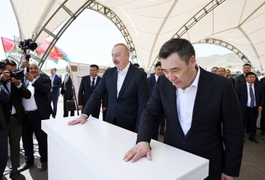The Iranian regular army’s ground forces have unveiled an upgraded multi-rotor smart bomber drone capable of flying up to one kilometer in altitude.
This new drone model was revealed during an exhibition held as part of the two-day annual “Eqtedar 1402.” (Strength 1402) drills in the central province of Isfahan, as reported by Fars News Agency on October 28.
The report highlights that this bomber drone has the capability to accurately target fixed objectives, observation towers, armored and anti-armor equipment, military bases, as well as enemy control and command centers.
One notable feature of this system is its silent engines, rendering it undetectable by enemy radar systems. Furthermore, the upgraded bomber drone is equipped with anti-jamming capabilities and is guided by a GPS system along with a ground station. It also possesses the ability to return to its original path autonomously in the event of control loss.
The new drone is equipped to carry six 2 kg-Simorgh bombs over a range of 2 km, with a maximum altitude of 1 km and an operational radius of 10 km.
During the “Eqtedar 1402” drills, Iran’s regular army conducted tests of the domestically developed Heydar cruise missile, which was launched from a helicopter and demonstrated precise targeting of intended objectives at a distance of 30 km during the exercise.
The Heydar missile features a GPS guidance system, providing complete trajectory control for the pilot. It measures 3.83 meters in length and weighs nearly 40 kg. The missile boasts the capability to engage both stationary and moving targets within a 200 km radius, with significant destructive power suitable for targeting armored units and fortified concrete structures.
Brigadier General Yousef Qorbani, commander of the helicopter division of Iran’s regular army, stated during the annual drills that helicopters within his division have been equipped with long-range air-to-surface missiles. He noted that some of these missiles were fired for the first time, highlighting their enhanced firepower.
The commander also mentioned the addition of jamming systems, night vision, and precision strike capabilities to the helicopters, emphasizing their use in night-time air defense operations along the coast.
The two-day exercise involved a diverse array of military equipment and weapons, including drones, missiles, and 200 helicopters.
On the main stage of the drill on October 27, the Army Ground Force’s mobile assault brigades, armored divisions, and helicopter squadrons fired upgraded versions of the Shafaq, Almas, and Dehlaviyeh missiles, targeting objectives at ranges of 8 to 20 kilometers.
The Dehlaviyeh twin-arm laser-guided missile launcher has recently been integrated into the M113 armored personnel carriers of the Army Ground Force. Iranian military experts have extended the range of Dehlaviyeh missiles, both ground-based and air-based, from 5.5 km to 8 km.
The troops in the drill also launched the air-based version of the Shafaq missile, which features a 50-kg warhead and the capability to destroy targets within a 20 km range at a speed of Mach 2.2.
Another domestically produced missile, Almas, is paired with an automatic fire control system, enabling it to hit various targets within an 8 km range. The air-based version of Almas is mounted on Bell Cobra 209 helicopters and combat drones.
The exercise involved the participation of various units, including infantry, armored, missile, artillery, air force, drone, engineering, electronic warfare, modern warfare, cyber, and ICT units, according to the spokesman for the drills and the deputy commander for Army Ground Forces Operations, Brigadier General Karim Cheshak.
He added that the drills emphasized four characteristics: distance, accuracy, intelligence, automation, and network-oriented equipment.
“The goals of this exercise are to assess the level of capability of combat units and support of the army’s ground forces, review ground combat tactics, operational assessment of new weapons, improve the deterrence power in the face of new threats, and also develop stable security,” the spokesman stated.
In recent years, Iranian military experts and technicians have achieved significant progress in domestically producing a wide range of equipment, attaining self-sufficiency in weaponry. Iranian officials have consistently stressed their commitment to enhancing military capabilities, including missile and drone technology, despite Western sanctions.
While the West has raised concerns about Tehran’s support for Russia in the Ukrainian conflict and the provision of arms, particularly kamikaze drones, Iran denies supplying these arms with the intent for use in the war. Instead, they acknowledge delivering a “limited number” of drones several months before the Russian invasion of Ukraine.







 President Ilham Aliyev shed light on the evolving contours of the peace process with Armenia during an international conference in Baku this week. ...
President Ilham Aliyev shed light on the evolving contours of the peace process with Armenia during an international conference in Baku this week. ...
 Azerbaijan and Armenia started the process of demarcation of their border on Tuesday, with the installation of the first border markers based on ge...
Azerbaijan and Armenia started the process of demarcation of their border on Tuesday, with the installation of the first border markers based on ge...
 Iranian President Ebrahim Raisi expressed Tehran’s readiness to participate in significant development projects in Sri Lanka during the inauguratio...
Iranian President Ebrahim Raisi expressed Tehran’s readiness to participate in significant development projects in Sri Lanka during the inauguratio...
 As the conflict between Ukraine and Russia escalates, the strategic importance of Kharkiv, Ukraine's second-largest city, has come sharply into focus.
As the conflict between Ukraine and Russia escalates, the strategic importance of Kharkiv, Ukraine's second-largest city, has come sharply into focus.
 Iran and Pakistan have signed eight cooperation documents in various fields, and agreed to strengthen ties to fight terrorism in the region.
Iran and Pakistan have signed eight cooperation documents in various fields, and agreed to strengthen ties to fight terrorism in the region.



